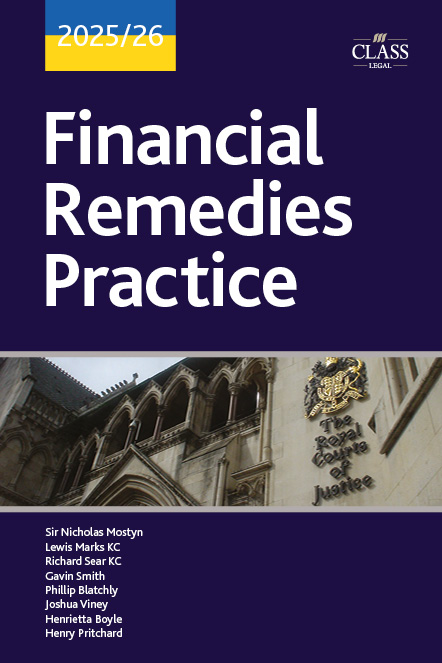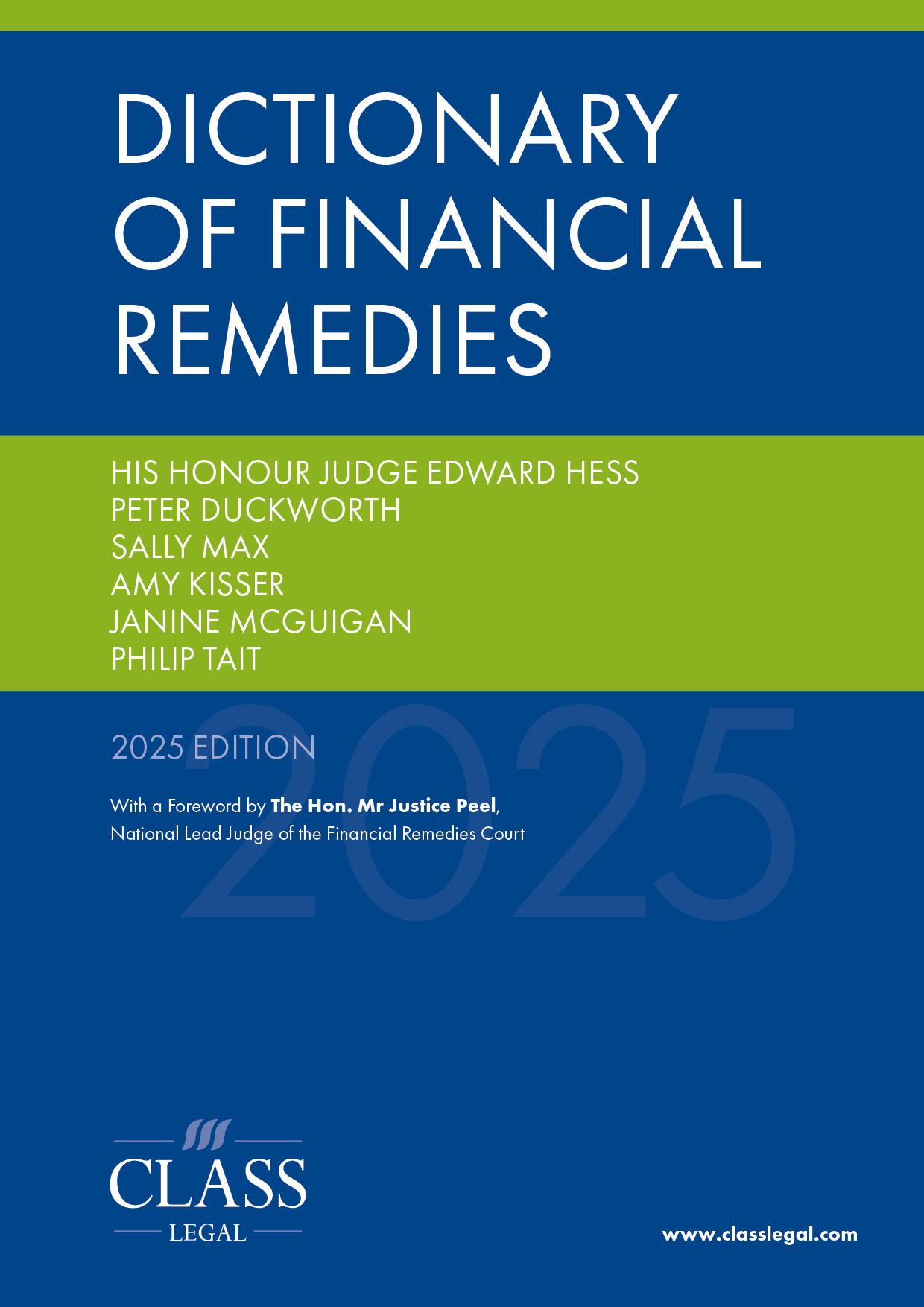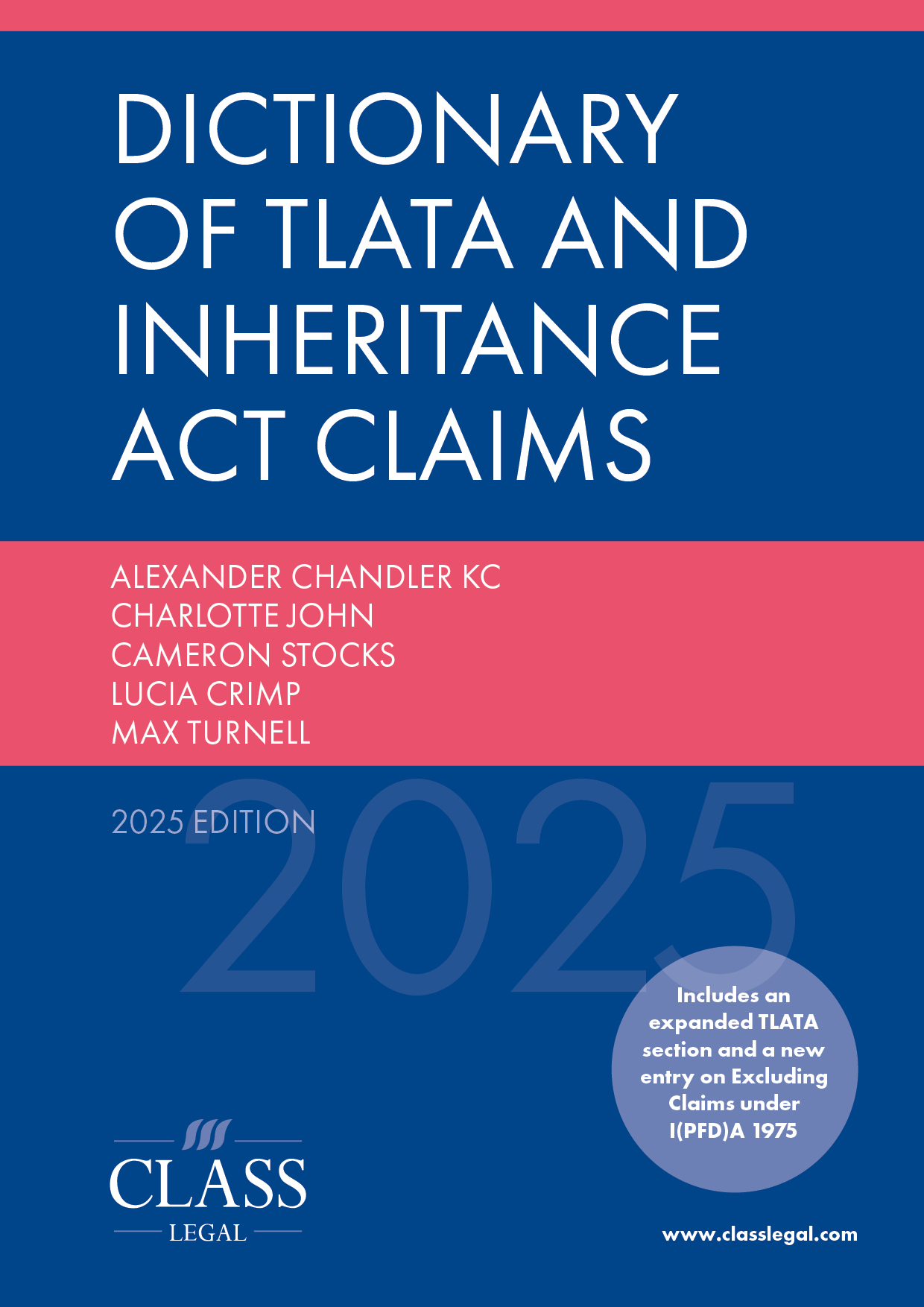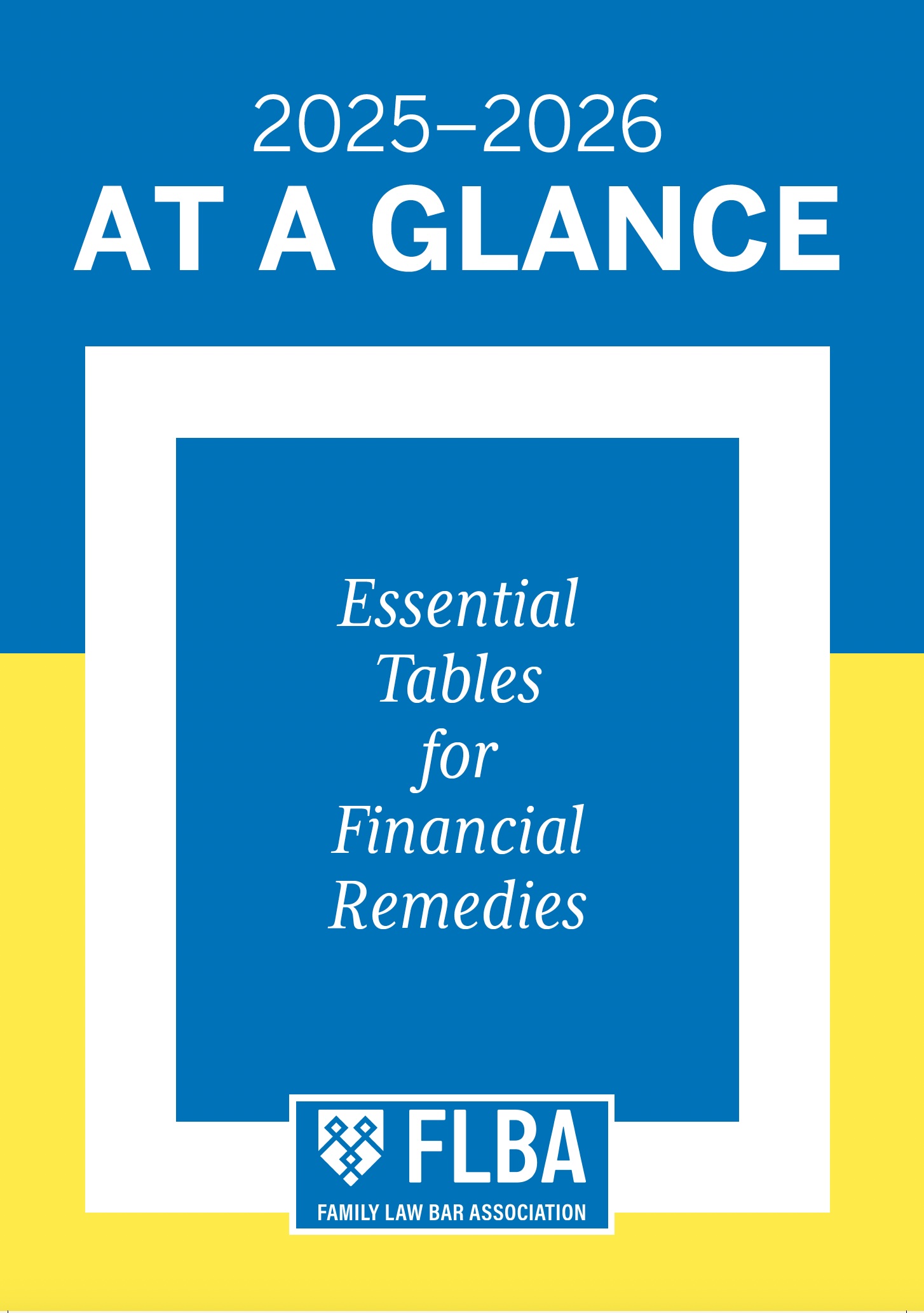
Betting the Farm
Published: 18/03/2025 06:00

‘The beleaguered Judge looked from farming case to financial remedy case, and from financial remedy case to farming case, and from farming case to financial remedy case again; but already it was impossible to say which was which.’
In an area of law that has many dedicated sub-genres, few are perceived as being as abstruse and esoteric as the idea of the ‘farming case’. The term is rolled out with such precision and certainty that one could be forgiven for expecting a separate section of the Matrimonial Causes Act 1973 to have been dedicated to its operation.
The first time the term is heard in practice, one has visions of some senior member of chambers being thawed out from cryostasis, already armed with a hard hat and hi-vis vest ready for a site visit.
Alas, the reality is not so exotic. Rather, ‘farming cases’ engage similar issues to cases more commonly encountered, albeit with the scope for difficulty being more pronounced due to: (1) their tendency to involve third parties (often with emotive and legitimate reasons to have an interest in the outcome); (2) an unclear process of valuation; (3) complicated issues of liquidity and tax; and (4) the range of routes to achieving a fair outcome being wider than one might entertain in other cases.
The difficulty is that the cases in which farms are dealt with are relatively few.
An option a judge will often need to consider is whether it is fair to force the sale of a farming enterprise (and/or related property) or whether it is possible to sell individual elements to fund a party’s financial remedy award. The latter form of outcome is of particular note in the light of the highly publicised changes in the Autumn 2024 Budget to Business Property Relief and Agricultural Property Relief and its consequent impact on inheritance tax planning for farmers.1
This article looks to deal with the issues encountered in ‘farming cases’ with reference to reported examples whilst setting them against general developments in the wider law since.
For a variety of reasons, the crux of the issue in these difficult cases tends to boil down to one central problem: how can the non-farming spouse’s award be met without causing irreparable damage to the wider farming enterprise?
Expert evidence
Instructing an appropriately experienced and locally knowledgeable expert at an early stage can assist the parties and their advisors to identify solutions that may not appear obvious at first blush. There are a small number of firms nationally who specialise in this work. An appropriate expert will be alive to the need to:
(1) establish the scope of the farming enterprise and its constituent parts (i.e. the basis of its ownership and whether there are parts of the enterprise (for instance particular dwellings or separate parcels of land) that can be separated and sold);
(2) value the operation with a particular eye on any contention that the value of different arms of the enterprise are interrelated;
(3) look at the best means of marketing land in the event of a sale (e.g. lotting for sale at auction; fencing off particular areas to create separation between the farming activity and dwellings that could be separately lived in; attracting interest from neighbouring residents that may pay a premium);
(4) assess any development or ‘hope’ value;
(5) identify any alternative commercial use of the land to which (part of) the farming enterprise may be put;
(6) advise as regards to financial support potentially available (for instance from the Rural Payments Agency); and
(7) identify obstacles to liquidity (for instance the detail of any tenancies).
Care must be taken in the drafting of any letter of instruction to a proposed expert, particularly as regards issues of liquidity (some may even go so far as to include possible routes to liquidity for the expert to consider, more on which below).
That expert should, in the ordinary course of events, be jointly instructed per Peel J in BR v BR [2024] 2 FLR 217 (and the judge’s list of prima facie reasons why at [18] are often intensely engaged in farming cases).
Computation and categorisation
Farming cases typically engage consideration of matrimonial and non-matrimonial property. The fact that the legal estate is vested in the name of one or other (or both) spouses, as explored in both White v White [2000] UKHL 54, [2000] 2 FLR 981 and Miller/McFarlane [2006] UKHL 24, [2006] 1 FLR 1186, must be viewed carefully in the context of the Court of Appeal’s decision in Standish v Standish [2024] EWCA Civ 567, [2024] 2 FLR 966 and the view expressed therein that ‘the source of an asset is the critical factor and not title’.2
In other words, the origin of the farm is a feature of importance, whether it is held in the parties’ joint names or otherwise.
Pre-acquired assets (a specie of non-matrimonial property) may, depending on the circumstances of the case, be treated differently from assets that were acquired during the marriage by the spouses’ joint efforts. In P v P (Inherited Property) [2004] EWHC 1364 (Fam), [2005] 1 FLR 576, which concerned a farm inherited by the husband,3 Munby J (as he then was) considered the different forms that inherited wealth could take:4
‘[37] There is inherited property and inherited property. Sometimes, as in White v White itself, the fact that certain property was inherited will count for little: see the observations of Lord Nicholls of Birkenhead at 611 and 995 respectively and of Lord Cooke of Thorndon at 615 and 998 respectively. On other occasions the fact may be of the greatest significance. Fairness may require quite a different approach if the inheritance is a pecuniary legacy that accrues during the marriage than if the inheritance is a landed estate that has been within one spouse’s family for generations and has been brought into the marriage with an expectation that it will be retained in specie for future generations.’
In Robson v Robson [2010] EWCA Civ 1171, [2011] 1 FLR 751 Ward LJ expanded on this distinction:
‘[43] How then does the court approach the “big money” case where the wealth is inherited? At the risk of over-simplification, I would proffer this guidance: …
(7) … The fact that wealth is inherited and not earned justifies it being treated differently from wealth accruing as the so-called “marital acquest” from the joint efforts (often by one in the work place and the other at home). It is not only the source of the wealth which is relevant but the nature of the inheritance. Thus the ancestral castle may (note that I say “may” not “must”) deserve different treatment from a farm inherited from the party’s father who had acquired it in his lifetime, just as a valuable heirloom intended to be retained in specie is of a different character from an inherited portfolio of stocks and shares. The nature and source of the asset may well be a good reason for departing from equality within the sharing principle.’
The provenance of the assets may prove to be determinative of outcome, as happened in P v P (Inherited Property) where the retention of the farm for future generations was an important factor which justified the wife being confined to an award that met her accommodation and income needs:
‘[44] … in the particular circumstances of this case, the proper approach is to make an award based on the wife’s reasonable needs for accommodation and income. I do that, applying the approach adopted by Bennett J in Norris v Norris [2003] 1 FLR 1142, not … because of any principle that this is the approach to be adopted in farming cases, but because in the particular circumstances of this case that is the approach which most closely accords with the over-arching requirement of fairness, having regard to all the circumstances but in particular to:
(i) the fact that the bulk of the family’s assets represent a farm which has been in the husband’s family for generations and which was brought into the marriage with an expectation that it would be retained in specie;
(ii) the fact that although the farm business was put into the parties’ joint names, the land and the other tangible assets were retained in the husband’s sole name;
(iii) the fact that any other approach will compel a sale of the farm, with implications little short of devastating for the husband; and
(iv) the fact that this approach will meet the wife’s reasonable needs.
In short, because to give this wife more than she reasonably needs for accommodation and income would tip the balance unfairly in her favour and unfairly against the husband.’
However, in D v D [2010] EWHC 138 (Fam), which concerned a gifted/inherited farming company that had been passed on through generations in the husband’s family,5 Charles J considered that to calculate the award to the wife solely on the basis of her needs would be wrong, notwithstanding the fact that it would be met from the husband’s interest in the farming company. He stated:
‘[154] At the heart of the husband’s case is the proposition, that as a matter of principle in the application of the sharing principle (that he accepts applies to all of the assets of the parties) his interest in the Company should for good reason be left wholly out of account because it is a gifted or inherited farming company. So, he says that as a matter of principle the award is to be based on, and only on the application of the need principle applying the s25 criteria to it (and so acknowledges that the departure from equality in respect of his interest in the Company that he argues for on the application of the sharing principle is subject to him meeting the wife’s claim based on need generously assessed).
[155] In my view this is wrong.
[156] A theme of the husband’s argument in support of this proposition was that as this was a “farming case” the principle to be applied in assessing the fair result is only the need principle or, put another way, the departure from equality in applying the sharing principle to the husband’s shares in the Company should be one that gives the husband 100% (and should be left out of account subject to the satisfaction of an award based on need).
[157] In my judgment, no such principle or approach can be founded on existing authority. Although, I accept that:
(i) a fair departure from equality for “good reason” in the application of the sharing principle can amount to a result that gives one party 100% of the value of the relevant assets, and
(ii) inherited or gifted land (and perhaps in particular estates and farms) that have been in a family for generations (or for less time) may found arguments that there should be such an approach,
in my view the cases do not show that simply because the relevant assets are, or derive from, gifted or inherited farms or farming assets (or estates) they are to be so treated with the result that there is no need to look further at the circumstances of the case to see what impact (if any) the sharing principle is to have on the ascertainment of the fair award.’
In R v R [2009] EWHC 1267 (Fam) Charles J had previously stated:
‘[162] … in the case of inherited or pre-acquired assets both the source and the nature of assets (e.g. whether it is the matrimonial home) are circumstances to be taken into account as are the length of the marriage and thus the period that inherited or pre-acquired assets have been enjoyed by the parties during their relationship (albeit that the sharing principle applies to short marriages, see Lord Nicholls in Miller paragraphs 17 and 22). They also show that the weight to be given to such matters is fact sensitive (see for example Vaughan v Vaughan [2008] 1 FLR 1108 at paragraph 49 and C v C [[2009] 1 FLR 8] at para [36]) and thus that the way in which such property has been treated, enhanced, damaged and regarded are all factors that can be taken into account.
[163] In my judgment, on that approach the points that property has not passed through generations, or is not a product of dynastic wealth, or after it was inherited it was used as the matrimonial home (particularly if before the marriage it was used as the home of the family of one of the parties to the marriage), do not mean that the fact that it is inherited property is irrelevant.’
Liquidity
Cases that involve an interest in an asset that is capable of being valued (such as company, a partnership or a farm), but which is not easily realisable either because it provides the means by which a person earns their livelihood, or there is no ready market, invariably pose problems of (il)liquidity.
When present, illiquidity can go to the quantification of the award as well as to the implementation of the order. In WM v HM (Financial Remedies: Sharing Principle: Special Contribution) [2017] EWFC 25, [2018] 1 FLR 313 Mostyn J stated:
‘[29] I am aware that in Chai v Peng and Others Bodey J divided the “kitty” 60:40 in favour of the husband because the wife’s award would be largely cash or easily realisable assets: at para [140]. I do not adopt that approach. A valuation of an asset is the estimate of what it will sell for now. If it is perceived as being hard to realise then its value will be discounted to reflect that difficulty. It does seem to me to use discounted figures and then to move away from equality is to take into account realisation difficulties twice. Whatever the asset the only difference between it and its cash proceeds is, as Thorpe LJ once memorably said, the sound of the auctioneer’s hammer.’
On appeal, in Martin v Martin [2018] EWCA Civ 2866, [2019] 2 FLR 291 Moylan LJ disagreed:
‘[87] … I propose to consider this in more detail, in particular because of the judge’s conclusion that there was no effective difference between the valuation of Dextra and its “cash proceeds” on a sale. The judge based his conclusion on the “auctioneer’s hammer” analogy and because he considered that the valuation was “the estimate of what it will sell for now” adding that, if “it is perceived as being hard to realise then its value will be discounted to reflect that difficulty” (at para [29]).
[88] I deal, first, with the judge’s reference to the “auctioneer’s hammer”. As Mr Marks demonstrated during the hearing, the judge’s reliance on what Thorpe LJ had said was misplaced and taken out of context. Thorpe LJ had not been referring to all assets but to a specific class of assets, namely “prime agricultural land”. The case was the Court of Appeal decision in White v White [1998] 2 FLR 310; he said, at 319:
“As to the difference between the paper value of an interest in farmland and cash in hand (for which the judge cited P v P (Financial Provision: Lump Sum) [1978] 1 WLR 483 and Preston v Preston (1981) 2 FLR 331) I would only say that the difference between a paper value of an interest in a farm partnership and cash in hand is dependent only upon the judgment of the valuer and future market fluctuations. Of course real value can only be established by signing a contract for the sale of the land and by the fall of hammer on the last lot of the farm sale. Of course there are substantial costs in turning farming assets into cash, although that factor was allowed for in the judge’s calculations. But there are few assets more stable, more predictably realisable and more proof against inflation than prime agricultural land.”
It can be seen that Thorpe LJ’s focus was on, and only on, “prime agricultural land”. He expressly identified why he considered that, whilst acknowledging that it depended on “the judgment of the valuer and future market fluctuations”, the valuation of this type [of] asset could be treated as being robust. As I have said, it was not a general observation about all assets and all valuations. …
[93] How is this to be applied in practice? As referred to by both King LJ and Lewison LJ [in Versteegh v Versteegh [2018] 2 FLR 1417] the broad choices are (i) “fix” a value; (ii) order the asset to be sold; and (iii) divide the asset in specie: at paras [134] and [195]. However, to repeat, even when the court is able to fix a value this does not mean that that value has the same weight as the value of other assets such as, say, the matrimonial home. The court has to assess the weight which can be placed on the value even when using a fixed value for the purposes of determining what award to make. This applies both to the amount and to the structure of the award, issues which are interconnected, so that the overall allocation of the parties’ assets by application of the sharing principle also effects a fair balance of risk and illiquidity between the parties. Again, I emphasise, this is not to mandate a particular structure but to draw attention to the need to address this issue when the court is deciding how to exercise its discretionary powers so as to achieve an outcome that is fair to both parties. I would also add that the assessment of the weight which can be placed on a valuation is not a mathematical exercise but a broad evaluative exercise to be undertaken by the judge.
[94] I would also add that this is not, as Mostyn J suggested, to take realisation difficulties into account twice. Nor, as submitted by Mr Pointer, will perceived risk always be reflected in the valuation. The need for this approach derives from the fact that, as said by Lewison LJ, there is a “difference in quality” between a value attributed to a private company and other assets. This is a relevant factor when the court is determining how to distribute the assets between the parties to achieve a fair outcome.’
In F v F (Clean Break: Balance of Fairness) [2003] 1 FLR 847 when considering the fairness of imposing a clean break in a case where company assets were illiquid, Singer J stated at [86]:
‘Liquidity, the ability to pay, finds no express reference amongst the s 25(2) “matters” to which the court is in particular directed to have regard, although clearly it is an element which can and often must be taken into account as one amongst “all the circumstances of the case”. I do not for a moment suggest other than that it is a highly relevant consideration, nor indeed the ease or difficulty with which any particular asset or class of asset can be realised should be disregarded when surveying the financial resources available to the parties. Liquidity can constitute an important element not only at the stage when the court considers the time for implementation of the order, but also at the earlier stage of arriving at a fair (albeit maybe only provisional) conclusion as to how the order should if practicable be fashioned.’
In Murphy v Murphy [2011] 1 FLR 537 the Court of Appeal allowed the appeal because of the failure to properly categorise an illiquid asset (a deferred compensation payment scheme) as such.
In N v N (Financial Provision: Sale of Company) [2001] 2 FLR 69 Coleridge J at [71] acknowledged that illiquidity was a reason for departure from equality of division:
‘I am sure the House of Lords [in White] did not intend courts to exercise their far-reaching powers to achieve equality on paper if in doing so they, Samson-like, brought down or crippled the whole family’s financial edifice to the ultimate detriment of the children (whose interests, of course, remain the top priority in this and every case). More than ever in the new climate, especially where the facts are similar to the present (where the award is likely to be larger than before White), the court, in my judgment, must be creative and sensitive to achieve an orderly redistribution of wealth, particularly where this involves the realisation of assets owned by either of the parties …’
In a situation where the value of the business is based on its future profitability, and the business is the only source from which the receiving party’s maintenance can be paid in the future, if that party received a lump sum representing a share of the business in addition to maintenance, they would be benefiting twice from the same asset and the court should avoid double counting.6
It is useful to recall that the evidential burden is (albeit loosely) on the person with assets to demonstrate an inability to borrow on the security of them (Newton v Newton [1990] 1 FLR 33).7
These differences of approach were helpfully drawn together and summarised by Peel J in HO v TL [2024] 2 FLR 200 at [20]–[27] inclusive (albeit not a case involving a farm, one can see how the judge’s observations might apply in such a case) and in particular:
‘[23] Third, I suggest that the reliability of a valuation will depend on a number of factors such as: (i) whether there are applicable comparables, (ii) how “niche” the business is, (iii) whether the business is to be valued on a net asset basis (for example a property company) or one of the recognised income approaches (such as EBITDA or DCF), (iv) the extent of the parties’ interests, and accordingly their level of control, (v) the extent of third party interests, (vi) the relevance of any shareholders’ agreements, (vii) whether there is a realistic market for sale, (viii) the volatility or otherwise of the figures, (ix) the reliability of forecasts, and (x) whether the assumptions underpinning the valuation are seriously in dispute.
[24] Fourth, in practice the choices for the court will be, per Moylan LJ in Martin v Martin [2018] EWCA Civ 2866 at para 93: (i) “fix” a value; (ii) order the asset to be sold; and, (iii) divide the asset in specie. The latter option (divide the asset in specie) is commonly referred to as Wells sharing (Wells v Wells [2002] EWCA Civ 476).
[25] Fifth, whether a business should be retained by one party, or sold, or divided in specie will depend on the facts of each case. Relevant features will include whether the business was founded during the marriage or pre-owned, whether it has its origins in one party’s non-marital wealth, whether the parties were both involved in its strategy and operation, the ownership structure of the business, whether Wells sharing is practical or realistic given that it will usually continue to tie the parties together to some extent, and how to ensure a fair allocation of all the resources in any given case.’
Distribution
Orders for sale
The extent to which the court will meet the problem posed by illiquid assets with an order for sale assumed greater significance in the light of the awards post-White and the introduction of the (equal) sharing principle. Prior to White, a submission that a working farm should be sold to meet a clean break award would in all likelihood have failed, yet Lord Nicholls in White contemplated that Mr White might have to sell the farms in order to meet the award, and he made no reference in his speech to illiquidity.
In N v N (Financial Provision: Sale of Company) [2001] 2 FLR 69 Coleridge J stated at p 80:
‘There is no doubt that had this case been heard before the White decision last year, the court would have strained to prevent a disruption of the husband’s business and professional activities except to the minimum extent necessary to meet the wife’s needs.
However, I think it must now be taken that those old taboos against selling the goose that lays the golden egg have largely been laid to rest; some would say not before time. Nowadays the goose may well have to go to market for sale, but if it is necessary to sell her it is essential that her condition be such that her egg laying abilities are damaged as little as possible in the process. Otherwise there is a danger that the full value of the goose will not be achieved and the underlying basis of any order will turn out to be flawed.’
This approach was echoed by Munby J (as he then was) in P v P (Inherited Property) [2004] EWHC 1364 (Fam), [2005] 1 FLR 576 where he observed at [38]:
‘That said, the reluctance to realise landed property must be kept within limits. After all, there is, sentiment apart, little economic difference between a spouse’s inherited wealth tied up in the long-established family company and a spouse’s inherited wealth tied up in the long-held family estates.’
A sale of small, outlying parcels of land, particularly any with development potential, may provide a means of creating liquidity without destroying viability and may qualify for business asset disposal relief from capital gains tax under the part-disposal rules.
Alternatives to a sale
To avoid the uninviting prospect of a sale of a company or a farm, creative ingenuity may on occasions be necessary if a fair and just result is to be achieved.
(1) Payment of the lump sum over a period of time
In R v R (Lump Sum Repayments) [2004] 1 FLR 9288 (a case where the vast bulk of the capital was represented by shares which had come to the husband by gift and inheritance but were tied up in a family farming company with capital illiquidity in which he had a substantial minority holding9), Wilson J (as he then was) ordered the payment by the husband of a lump sum by 240 monthly instalments over a period of 20 years in a sum equivalent to the mortgagor wife’s obligations under a mortgage (totalling £225,000), and for the sums to be secured on the husband’s shares in the family farming business. The order was variable10 but would endure beyond the wife’s death or remarriage and be binding upon the husband’s estate.
The court therefore accepted the husband’s contention that the majority of his capital was tied up and could not be realised to raise a lump sum immediately. The solution arose from the husband’s income from the farm which, once his other benefits were taken into account, left sufficient surplus to pay the wife both periodical payments and a series of lump sums which would eventually ensure that she owned her own property outright.
The R v R solution requires sufficient income on the part of the payer to enable such payments to be made (from the farm partnership income or, in a company case, from the salary and dividends of the farming party). In such a case, practical matters to consider include the following:
(a) the need for mortgage quotes for the payee;
(b) the need for approval in principle from the mortgagee;
(c) a focus on the viable income potential of the farm/other income of the payer;
(d) the possible need for an additional undertaking of the payer to act as guarantor; and
(e) the need to draft security for the lump sum instalment payments (with a legal charge drafted and appended to any financial remedy order).
(2) Variation of a nuptial settlement
MCA 1973, s 24(1)(c) provides that the court may make an order ‘varying for the benefit of the parties to the marriage and of the children of the family or either or any of them any ante-nuptial or post-nuptial settlement … made on the parties to the marriage’.
Detailed consideration of this jurisdiction is outwith the scope of this article. However, it should be noted that the court’s power to vary a nuptial settlement only applies to property held to be within that settlement and hence the court’s first task is to discern what that property is. For example, if a marital farmhouse has been settled on trust, the trust may extend to the whole beneficial interest in the property or merely to a right to either or both parties to occupy (effectively, a licence). The trust deed itself will be the primary document to establish the assets of the settlement. If there is no trust deed in existence, the court will look to any further evidence relevant to the settlor’s intentions and the parties’ conduct (see, for example, D v D and the I Trust [2011] 2 FLR 29 per Baron J). Even if there is a trust deed, interpretation of its terms may be required to determine what property and assets are held by the trust.
If the court is satisfied that the farming enterprise is a nuptial settlement it has jurisdiction over it. The next stage of the enquiry is then whether or not it should exercise its discretion and, if so, in what manner.
The principles underpinning a variation were summarised in Ben Hashem v Al Shayif [2008] EWHC 2380 (Fam), [2009] 1 FLR 115 per Munby J (as he then was):
‘[290] Surveying all this learning, identifying what is of enduring significance whilst ruthlessly jettisoning what has become more or less irrelevant in modern conditions, I can perhaps summarise matters as follows:
i. The court’s discretion under section 24(1)(c) is both unfettered and, in theory, unlimited. As Miss Parker put it, no limit on the extent of the power to vary or on the form any variation can take is specified, so it is within the court’s powers to vary (at one end of the scale) by wholly excluding a beneficiary from a settlement, to (at the other end) transferring some asset or other to a non-beneficiary free from all trusts. […].
ii. That said, the starting point is section 25 of the 1973 Act, so the court must, in the usual way, have regard to all the circumstances of the case and, in particular, to the matters listed in section 25(2)(a)–(h).
iii. The objective to be achieved is a result which, as far as it is possible to make it, is one fair to both sides, looking to the effect of the order considered as a whole.
iv. The settlement ought not to be interfered with further than is necessary to achieve that purpose, in other words to do justice between the parties.
v. Specifically, the court ought to be very slow to deprive innocent third parties of their rights under the settlement. If their interests are to be adversely affected then the court, looking at the wider picture, will normally seek to ensure that they receive some benefit which, even if not pecuniary, is approximately equivalent, so that they do not suffer substantial injury. […]
[291] Miss Parker submitted that the central theme which permeates these authorities is that it is permissible for the court to invade third party interests within the confines of the trust structure, but only to the extent that fairness so requires. It is acknowledged that in the generality of cases, the court should indeed be slow to do so. Broadly speaking, I accept that submission.’
In farming cases, variation applications may be of importance, for example:
(a) the family home may be a farmhouse, occupied by the parties but held on trust, perhaps for the ultimate benefit of the children of the family. If this trust is a nuptial settlement, it may be open to variation to provide, at its extreme, access to the capital (the property equity) or otherwise, to provide property security for life, or some other term;
(b) if the farmland is held on trust (and is a nuptial settlement), and the trust structure itself is being relied on as an impediment to sale, variation may ‘free up’ the land from the restrictions of the trust; and/or
(c) if other assets of the marriage are held within a trust which amounts to a nuptial settlement, a variation application may release assets so as to enable the farm to be retained in specie.
In D v D & Ors and the I Trust [2011] 2 FLR 29 Baron J held that the parties’ main asset – the substantial matrimonial home (a working farm), which at the time of the marriage had been held in the husband’s sole name and which had been placed in a Jersey trust (through the intermediary of two BVI companies) before the separation – was a nuptial settlement given that (at [132]) the husband and the wife each derived a benefit from the whole of the farm because: (a) it provided a home for the parties; and (b) for the husband throughout; and (c) the parties lived off and, therefore, derived a benefit from the income which the whole of the farming (in its loosest sense) enterprise engendered.
AB v CB (Financial Remedy: Variation of Trust) [2015] 2 FLR 25 was not a classic ‘farming case’. The husband was a copywriter and the wife a journalist. However, the husband’s parents were wealthy and he was also involved in the family business. The husband’s parents initially owned the farmhouse in which the parties lived but during the course of the marriage the husband’s father set up a trust fund of which the primary property was the farmhouse, and the principal beneficiary was the husband.11 The husband had no significant capital assets of his own, albeit Mostyn J found that he enjoyed financial security by reason of his family’s wealth. The equity in the farmhouse was circa £314,000.
Mostyn J considered that, ignoring the trust complications, the starting point would have been that the wife was entitled to 50%. He determined that she should receive £7,500 from the husband and £23,000 outright from the trust. Additionally, he directed that £134,000 be extracted from the trust fund, to be held by independent trustees, and appointed to the wife on the terms of a life tenancy, with no power of advancement so that the sum would revert to the fund upon her death. The combination of the wife’s own resources and the sums provided outright and by way of a life tenancy would be sufficient to meet her housing needs. Together with the absolute lump sum, this corresponded to half the value of the farmhouse held within the trust and enabled her to rehouse.
The trustees appealed to the Court of Appeal.12 P v P (Variation of Post-Nuptial Settlement) [2016] 1 FLR 437 provides both a clear exposition of the principles applicable to an application for an order varying a settlement under MCA 1973, s 24(1)(c) and a note of caution not to overstate the impact of any variation on other beneficiaries of a settlement. The following factors were important: (a) had the parties remained married, the wife would have had the continued benefit of living in the farmhouse; (b) the children beneficiaries were not overly prejudiced as the entire trust property (the farmhouse) would have provided a home to the parents during their marriage; and (c) the trust powers entitled the trustees to transfer the entire trust property to the husband absolutely. The trustees’ argument that the farmhouse was integral to the activities of the farming business was undermined by the intention underlying the trust that it would provide a permanent home for the husband. Furthermore, the order did not compel a sale of the farmhouse if the husband’s family could make the sum due to the wife available from other sources.
As to procedure, an application for a variation of a nuptial settlement engages FPR 9.13. This requires service of the application on the trustees and thereafter entitles the trustees to request a copy of the applicant’s Form E prior to deciding how to respond to the application by filing a statement in answer. This was described by Mostyn J in DR v GR & Ors (Financial Remedy: Variation of Overseas Trust) (at [32]) as their ‘obvious right’.
There is disagreement between Mostyn J and Moor J as to whether FPR 9.13 requires joinder of the trustees pursuant to FPR 9.26B.13 Mostyn J is of the view that this is not required as he makes clear in DR v GR & Ors (Financial Remedy: Variation of Overseas Trust). Moor J reached a different conclusion in TM v AH [2016] EWHC 572 (Fam).
(3) Traditional capital and income
In D v D [2010] EWHC 138 (Fam) Charles J considered that the award to the wife should be constructed upon the ‘building blocks’ of the husband being allowed to retain the company, and her being awarded the family home. In order to meet the wife’s capital and income needs on a clean break basis, he considered that she would need circa £2.2m, in addition to the house. This would require a dividend from the company of circa £3m, which was not realistic.
In the circumstances, a clean break could only be achieved by either limiting the wife to an award that was below what was fair or requiring the husband to take a very high risk to raise money that the company could not afford. Neither option was attractive, and so the clean break had to be sacrificed. Charles J ordered transfer of the family home to the wife, that the husband pay a substantial but affordable lump sum (£1.5m) and that the balance of the wife’s income needs be met by periodical payments.
In P v P (Inherited Property) Munby J (as he then was) determined that the wife’s award should be based upon an assessment of her reasonable needs and rejected the husband’s attempts to limit that to his free capital. She was awarded a lump sum of £575,000, which amounted to approximately 25% of the assets, the majority of which husband had inherited. The husband’s objections that such an award would necessitate the sale of the farm were given short shrift.14
(4) Other solutions
Other potential solutions include:
(a) awarding substantial periodical payments in return for a smaller lump sum;15
(b) letting relations assist in raising capital, if they have an incentive to do so (e.g. to gain vacant possession);16
(c) selling part of the farm. This has featured in a number of decided cases.17 If the farm is tenanted rather than owned, the question of a part sale will be more problematic, but it may be possible to sell, say, animals without unduly damaging the holding;
(d) selling part of the land to the applicant and letting him/her lease it back to the farm.18 Alternatively, identify parts that may have potential for development, or use for (say) stabling and livery, and allowing the applicant to develop this as an independent business;19
(e) transferring illiquid assets to the other party, so that both parties have a stake in illiquid assets;
(f) adjourning the application for a lump sum;20
(g) imposing a deferred charge on the farmland in case there is a later sale, whether of the whole or part, by the occupying spouse;21
(h) approaching the Agricultural Mortgage Corporation Plc (the AMC) – which specialises in long-term mortgages and loans for farms and rural businesses – for a loan. Provided it has suitable security, the AMC will usually lend on a good loan-to-value ratio, and at competitive rates, over the lifetime of the borrowers and even into the next generation;
(i) looking at any potential for assigning tenancies at a premium; and
(j) considering with accountants how rollover and business asset disposal relief can best be employed to limit exposure to capital gains tax (CGT).
Tax issues
As announced in the Autumn 2024 Budget, Business Asset Disposal Relief (one of the main reliefs from CGT and known as Entrepreneurs’ Relief before 6 April 2020) will remain at the current 10% rate on a lifetime limit of £1m of qualifying capital gains for the remaining 2024/25 tax year, but will increase to 14% for disposals made on or after 6 April 2025, and to 18% for disposals made on or after 6 April 2026. These changes will almost double the current rate of CGT for individuals disposing of business assets (including farming assets) within the lifetime limit. Existing valuations of farms by an expert may therefore need to be updated to reflect the increase in tax, with consideration given as to whether to impute the 14% or 18% rates.
These changes are in addition to the immediate increase in the main rates of CGT, with the lower rate rising from 10% to 18% for non and basic rate taxpayers, and from 20% to 24% for higher rate taxpayers, on disposals made on or after 30 October 2024. The changes, which brings all asset classes into the same band (residential property gains already being taxed at 18% and 24%), does particularly target non or basic rate taxpayers. This will be pertinent in cases in which the lower rate income taxpayer holds most of the assets that are heavy with gains. Careful consideration will need to be given to whether any of this tax liability can be mitigated, who will be responsible for its payment, and whether indemnities for payment will be required.22
- Matrimonial and Non-Matrimonial Property
- Nuptial Settlements
- Farms
- Autumn 2024 Budget
- Taxation
- Farming Case












